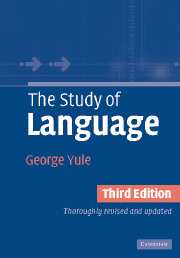Book contents
- Frontmatter
- Contents
- Preface
- The origins of language
- Animals and human language
- The development of writing
- The sounds of language
- The sound patterns of language
- Words and word-formation processes
- Morphology
- Phrases and sentences : grammar
- Syntax
- Semantics
- Pragmatics
- Discourse analysis
- Language and the brain
- First language acquisition
- Second language acquisition/learning
- Gestures and sign languages
- Language history and change
- Language and regional variation
- Language and social variation
- Language and culture
- Appendix: Suggested answers to study questions
- Glossary
- References
- Index
Second language acquisition/learning
- Frontmatter
- Contents
- Preface
- The origins of language
- Animals and human language
- The development of writing
- The sounds of language
- The sound patterns of language
- Words and word-formation processes
- Morphology
- Phrases and sentences : grammar
- Syntax
- Semantics
- Pragmatics
- Discourse analysis
- Language and the brain
- First language acquisition
- Second language acquisition/learning
- Gestures and sign languages
- Language history and change
- Language and regional variation
- Language and social variation
- Language and culture
- Appendix: Suggested answers to study questions
- Glossary
- References
- Index
Summary
“Easter is a party for to eat of the lamb,” the Italian nanny explained. “One too may eat of the chocolate.”
“And who brings the chocolate?” the teacher asked.
I knew the word, so I raised my hand, saying, “The rabbit of Easter. He bring of the chocolate.”
“A rabbit?” The teacher, assuming I'd used the wrong word, positioned her index fingers on top of her head, wriggling them as though they were ears. “You mean one of these? A rabbit rabbit?”
“Well, sure,” I said. “He come in the night when one sleep on a bed. With a hand he have a basket and foods.”
The teacher sighed and shook her head. As far as she was concerned, I had just explained everything that was wrong with my country. “No, no,” she said. “Here in France the chocolate is brought by a big bell that flies in from Rome.”
I called for a time-out. “But how do the bell know where you live?”
“Well,” she said, “how does a rabbit?”
Sedaris (2000)Some children grow up in a social environment where more than one language is used and are able to acquire a second language in circumstances similar to those of first language acquisition. Those fortunate individuals are bilingual (see chapter 18). However, most of us are not exposed to a second language until much later and, like David Sedaris, our ability to use a second language, even after years of study, rarely matches ability in our first language.
- Type
- Chapter
- Information
- The Study of Language , pp. 162 - 171Publisher: Cambridge University PressPrint publication year: 2005



